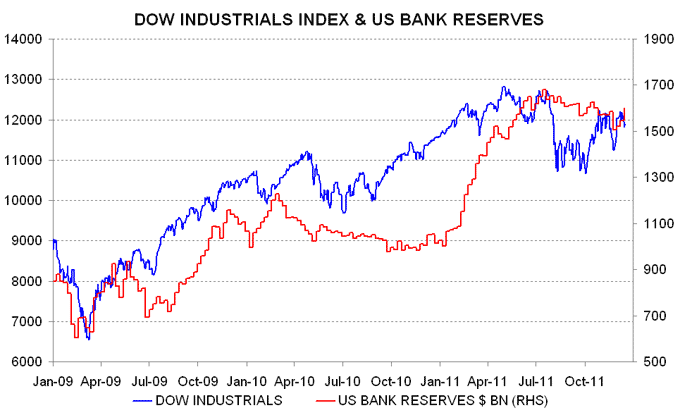"The Bernanke market" - an update
In a Wall Street Journal article in July 2009, Andy Kessler drew attention to a remarkable correlation that had developed between US stocks and the monetary base (i.e. currency in circulation plus bank reserves). Kessler suggested that the market had become dependent on “Mr. Bernanke’s magic dollar dust”.
The Fed’s liquidity operations have continued to influence stocks over the subsequent two and a half years, judging from the chart, showing the Dow Industrials index and bank reserves, which now dominate the monetary base.
Until mid 2010, reserve movements led the market; the sell-off in stocks in the late spring and early summer of that year, for example, was preceded by a contraction in reserves as the Fed ended its QE1 bond-buying operation.
Investors seem then to have cottoned on to the relationship, bidding stocks significantly higher in autumn 2010 after Mr. Bernanke signalled his intention of launching QE2 but ahead of the impact on reserves, which began to surge only from year-end.
In 2011, bank reserves hit a new record in mid-July, just after the end of QE2, with this high roughly coinciding with a secondary peak in stocks before a late summer plunge. The subsequent market recovery has returned the Dow to a level consistent with the modest decline in reserves from their July top.
Bank reserves have risen in each of the last three weeks, with the latest $55 billion increase mainly due to the Fed’s swap lending to the ECB. Another surge is unlikely barring QE3 but reserves could continue to edge higher, either because the swap operation expands further or ECB / Fed backstopping of the European banking system leads to a reduction in foreign official institutions’ precautionary balances at the Fed, thereby releasing liquidity into the market.
G7 bank reserves are being boosted, additionally, by an expansion of ECB lending and UK QE2, and may reach a new record over coming weeks.
Equity markets, therefore, should be underpinned to the extent that central bank liquidity remains a key driver.


Reader Comments